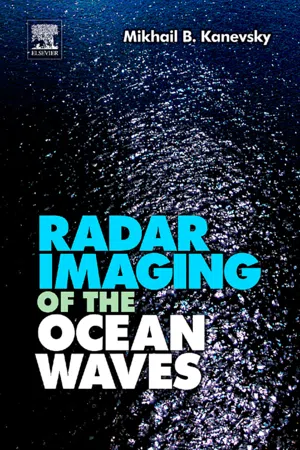
- 208 pages
- English
- ePUB (mobile friendly)
- Available on iOS & Android
eBook - ePub
Radar Imaging of the Ocean Waves
About this book
This book is dedicated to studying the ocean with radar tools, in particular, with space radars. Being intended mainly for the scientists preoccupied with the problem (as well as senior course students), it concentrates and generalizes the knowledge scattered over specialized journals. The significant part of the book contains the results obtained by the author.- Systematically collects and describes the approaches used by different laboratories and institutions- Deals with the physics of radar imagery and specifically with ocean surface imagery- Useful for students and researchers specializing in the area of ocean remote sensing using airborne or space-borne radars, both SAR and RAR
Frequently asked questions
Yes, you can cancel anytime from the Subscription tab in your account settings on the Perlego website. Your subscription will stay active until the end of your current billing period. Learn how to cancel your subscription.
No, books cannot be downloaded as external files, such as PDFs, for use outside of Perlego. However, you can download books within the Perlego app for offline reading on mobile or tablet. Learn more here.
Perlego offers two plans: Essential and Complete
- Essential is ideal for learners and professionals who enjoy exploring a wide range of subjects. Access the Essential Library with 800,000+ trusted titles and best-sellers across business, personal growth, and the humanities. Includes unlimited reading time and Standard Read Aloud voice.
- Complete: Perfect for advanced learners and researchers needing full, unrestricted access. Unlock 1.4M+ books across hundreds of subjects, including academic and specialized titles. The Complete Plan also includes advanced features like Premium Read Aloud and Research Assistant.
We are an online textbook subscription service, where you can get access to an entire online library for less than the price of a single book per month. With over 1 million books across 1000+ topics, we’ve got you covered! Learn more here.
Look out for the read-aloud symbol on your next book to see if you can listen to it. The read-aloud tool reads text aloud for you, highlighting the text as it is being read. You can pause it, speed it up and slow it down. Learn more here.
Yes! You can use the Perlego app on both iOS or Android devices to read anytime, anywhere — even offline. Perfect for commutes or when you’re on the go.
Please note we cannot support devices running on iOS 13 and Android 7 or earlier. Learn more about using the app.
Please note we cannot support devices running on iOS 13 and Android 7 or earlier. Learn more about using the app.
Yes, you can access Radar Imaging of the Ocean Waves by Mikhail B. Kanevsky in PDF and/or ePUB format, as well as other popular books in Physical Sciences & Environmental Science. We have over one million books available in our catalogue for you to explore.
Information
Chapter Synthetic aperture radar
SAR images the scattering surface from large distances, particularly, from space when the target resolution cannot be achieved by enlarging the physical aperture of the radar antenna. Here we are speaking about resolution over azimuthal coordinate, as the range resolution just as with RAR can be reached by deploying either rather short pulses, or chirp pulses with further compression (see Chapter 1). Basic concepts of SAR Earth surface imaging are covered in Chapter 1; this chapter is devoted to the specifics of ocean surface random movement.
6.1. Preliminary Estimates
We have mentioned above that SAR as an ocean surface probing tool is not in any way equivalent to incoherent side-looking radar having hypothetically super high resolution. To obtain preliminary estimates of roughness influence on SAR imaging of the ocean surface we consider expression (1.4):(6.1)

Having still the notion of SAR as a linear system it is easy to prove that the roughness-associated phenomena are the shift and expanding of the resolution cell.
In expression (1.8) for the complex amplitude of backscattered field(6.2)




We separate from Eqn. (6.2) the expressions for the Doppler frequency of the signal backscattered from the point scatterer:(6.4)

Let there be n point scatterers with variously valued and directed velocities as well as random and mutually non-correlated values of the reflection coefficient in the resolution cell. Then we substitute(6.5)

Table of contents
- Copyright
- Brief Table of Contents
- Table of Contents
- List of Figures
- List of Tables
- Introduction
- Chapter . Preliminary notes on radar imaging
- Chapter . Description of the sea surface
- Chapter . Sea scattering of radio waves
- Chapter . Microwave Doppler spectrum at moderate incidence angles
- Chapter . Real aperture side-looking radar
- Chapter . Synthetic aperture radar
- Chapter . Advanced radars and ocean surface imaging
- Appendix Appendix A
- Appendix Appendix B
- Appendix Appendix C
- Bibliography